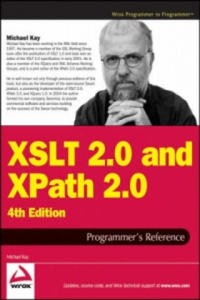altova
- znaleziono 9 produktów w 3 sklepach
Altova MapForce 2017 Basic Edition Altova
Oprogramowanie > Programy graficzne > Mapowanie danych
Altova Mapforce jest graficznym narzędziem przeznaczonym do mapowania, konwersji oraz integracji danych typu any-to-any. Narzędzie mapuje dane między dowolną kombinacją XML, plików, baz, Excel, EDI, XBRL i/lub Web Service. Transformacja danych przeprowadzana jest natychmiastowo. Altova MapForce automatycznie generuje kod obsługujący rzutowanie danych w językach XSLT 1.0/2.0, XQuery, Java, C++, and C#. Dzięki zaawansowaniu MapForce integracja danych pochodzących z wielu źródeł i zapisanych w wielu formatach będzie zadaniem wyjątkowo prostym i szybkim. Warto dodać, że nowoczesny silnik pozwala na mapowanie
Sklep: Vebo.pl
Altova MissionKit 2017 Enterprise Edition Altova
Oprogramowanie > Programy narzędziowe > Zabezpieczanie danych
Altova MissionKit to pakiet do tworzenia oprogramowanie narzędzi XML, SQL i UML, który zapewnia 7 profesjonalnych narzędzi. Pakiet zawiera rozwiązania Enterpise: Altova XMLSpy 2017 Altova MapForce 2017 Altova StyleVision 2017 Altova UModel 2017 Altova DiffDog 2017 Altova DatabaseSpy 2017 Altova SchemaAgent 2017 Objaśnienie do licencji: Installed User - To zakup tylu licencji na ilu komputerach potrzebujemy ją zainstalować. Concurent User - Model licencji współużytkownika dopuszcza możliwość instalacji oprogramowania udostępnianego w ramach pojedynczej licencji na maksymalnie 10 komputerach pod warunkiem, że wszystkie jednocześnie pracują w obrębie sieci lokalnej. Przykładowo jeśli użytkownik zakupi licencję obejmującą 20 stanowisk, oprogramowanie można zainstalować na maksymalnie 200 maszynach, ale tylko 20 może używać go w tym samym czasie. Named User - Każdą zakupioną licencje można zainstalować na maksymalnie 5 komputerach, gdzie tylko użytkownik o określonej nazwie i licencji może korzystać z oprogramowania. SMP (Support and Maintenance Package) - wsparcie techniczne producenta, aktualizacje do wszystkich nowych wydań programu Oficjalna strona producenta:
Sklep: Vebo.pl
Altova MissionKit 2017 Professional Edition Altova
Oprogramowanie > Programy narzędziowe > Zabezpieczanie danych
Altova MissionKit to pakiet do tworzenia oprogramowanie narzędzi XML, SQL i UML, który zapewnia 5 profesjonalnych narzędzi. Pakiet zawiera rozwiązania Professional: Altova XMLSpy 2017 Altova MapForce 2017 Altova StyleVision 2017 Altova UModel 2017 Altova DatabaseSpy 2017 Objaśnienie do licencji: Installed User - To zakup tylu licencji na ilu komputerach potrzebujemy ją zainstalować. Concurent User - Model licencji współużytkownika dopuszcza możliwość instalacji oprogramowania udostępnianego w ramach pojedynczej licencji na maksymalnie 10 komputerach pod warunkiem, że wszystkie jednocześnie pracują w obrębie sieci lokalnej. Przykładowo jeśli użytkownik zakupi licencję obejmującą 20 stanowisk, oprogramowanie można zainstalować na maksymalnie 200 maszynach, ale tylko 20 może używać go w tym samym czasie. Named User - Każdą zakupioną licencje można zainstalować na maksymalnie 5 komputerach, gdzie tylko użytkownik o określonej nazwie i licencji może korzystać z oprogramowania. SMP (Support and Maintenance Package) - wsparcie techniczne producenta, aktualizacje do wszystkich nowych wydań programu Oficjalna strona producenta:
Sklep: Vebo.pl
Altova XMLSpy 2017 Professional Edition Altova
Oprogramowanie > Programy narzędziowe > Edytory XML
Altova XMLSpy 2017 jest najlepiej sprzedającym się edytorem XML w branży modelowania, edycji, przetwarzania i technologii związanych z debugowaniem XML. Oferuje on schemat graficzny, generator kodu, debugery, pełną integracje z bazą danych, wsparcie dla XSLT, XPath, XQuery, WSDL, SOAP, XBRL, JSON oraz Office Open XML (OOXML) plus integracje z Visual Studio i Eclipse. Nowości w wersji 2017: Nowe funkcje wyszukiwania w widoku tekstowym Podświetlanie tekstów powiązanych Nowe polecenia, aby przejść do elementu nadrzędnego w widoku tekstowym Walidacja plików schematu Apache Avro Wizualizacja Apache Avro w specjalnym widoku siatki Nowe funkcje XSLT/XQuery Wsparcie dla pakietów XBRL Wsparcie dla sterowników baz danych ADO.NET Natywne wsparcie dla PostgreSQL Wsparcie dla baz danych Progress OpenEdge Wsparcie dla SQL Server 2016 Edycja nagłówek, stopek dynamicznych tabeli HTML i CALS Wsparcie dla integracji z Eclipse 4.6 Objaśnienie do licencji: Installed User - To zakup tylu licencji na ilu komputerach potrzebujemy ją zainstalować. Concurent User - Model licencji współużytkownika dopuszcza możliwość instalacji oprogramowania udostępnianego w ramach pojedynczej licencji na maksymalnie 10 komputerach pod warunkiem, że wszystkie jednocześnie pracują w obrębie sieci lokalnej. Przykładowo jeśli użytkownik zakupi licencję obejmującą 20 stanowisk, oprogramowanie można zainstalować na maksymalnie 200 maszynach, ale tylko 20 może używać go w tym samym czasie. Named User - Każdą zakupioną licencje można zainstalować na maksymalnie 5 komputerach, gdzie tylko użytkownik o określonej nazwie i licencji może korzystać z oprogramowania. SMP (Support and Maintenance Package) - wsparcie techniczne producenta, aktualizacje do wszystkich nowych wydań programu Oficjalna strona producenta:
Sklep: Vebo.pl
Altova MapForce 2017 Enterprise Edition Altova
Oprogramowanie > Programy graficzne > Mapowanie danych
Altova Mapforce jest graficznym narzędziem przeznaczonym do mapowania, konwersji oraz integracji danych typu any-to-any. Narzędzie mapuje dane między dowolną kombinacją XML, plików, baz, Excel, EDI, XBRL i/lub Web Service. Transformacja danych przeprowadzana jest natychmiastowo. Altova MapForce automatycznie generuje kod obsługujący rzutowanie danych w językach XSLT 1.0/2.0, XQuery, Java, C++, and C#. Dzięki zaawansowaniu MapForce integracja danych pochodzących z wielu źródeł i zapisanych w wielu formatach będzie zadaniem wyjątkowo prostym i szybkim. Warto dodać, że nowoczesny silnik pozwala na mapowanie
Sklep: Vebo.pl
Altova MapForce 2017 Professional Edition Altova
Oprogramowanie > Programy graficzne > Mapowanie danych
Altova Mapforce jest graficznym narzędziem przeznaczonym do mapowania, konwersji oraz integracji danych typu any-to-any. Narzędzie mapuje dane między dowolną kombinacją XML, plików, baz, Excel, EDI, XBRL i/lub Web Service. Transformacja danych przeprowadzana jest natychmiastowo. Altova MapForce automatycznie generuje kod obsługujący rzutowanie danych w językach XSLT 1.0/2.0, XQuery, Java, C++, and C#. Dzięki zaawansowaniu MapForce integracja danych pochodzących z wielu źródeł i zapisanych w wielu formatach będzie zadaniem wyjątkowo prostym i szybkim. Warto dodać, że nowoczesny silnik pozwala na mapowanie
Sklep: Vebo.pl
Altova XMLSpy 2017 Enterprise Edition Altova
Oprogramowanie > Programy narzędziowe > Edytory XML
Altova XMLSpy 2017 jest najlepiej sprzedającym się edytorem XML w branży modelowania, edycji, przetwarzania i technologii związanych z debugowaniem XML. Oferuje on schemat graficzny, generator kodu, debugery, pełną integracje z bazą danych, wsparcie dla XSLT, XPath, XQuery, WSDL, SOAP, XBRL, JSON oraz Office Open XML (OOXML) plus integracje z Visual Studio i Eclipse. Wersja Enterprise zapewnia najbardziej zaawansowane funkcje, w tym wsparcie dla XBRL, Web services, generowanie kodu oraz generowaniu wykresów. Nowości w wersji 2017: Nowe funkcje wyszukiwania w widoku tekstowym Podświetlanie tekstów powiązanych Nowe polecenia, aby przejść do elementu nadrzędnego w widoku tekstowym Walidacja plików schematu Apache Avro Wizualizacja Apache Avro w specjalnym widoku siatki Nowe funkcje XSLT/XQuery Wsparcie dla pakietów XBRL Wsparcie dla sterowników baz danych ADO.NET Natywne wsparcie dla PostgreSQL Wsparcie dla baz danych Progress OpenEdge Wsparcie dla SQL Server 2016 Edycja nagłówek, stopek dynamicznych tabeli HTML i CALS Wsparcie dla integracji z Eclipse 4.6 Objaśnienie do licencji: Installed User - To zakup tylu licencji na ilu komputerach potrzebujemy ją zainstalować. Concurent User - Model licencji współużytkownika dopuszcza możliwość instalacji oprogramowania udostępnianego w ramach pojedynczej licencji na maksymalnie 10 komputerach pod warunkiem, że wszystkie jednocześnie pracują w obrębie sieci lokalnej. Przykładowo jeśli użytkownik zakupi licencję obejmującą 20 stanowisk, oprogramowanie można zainstalować na maksymalnie 200 maszynach, ale tylko 20 może używać go w tym samym czasie. Named User - Każdą zakupioną licencje można zainstalować na maksymalnie 5 komputerach, gdzie tylko użytkownik o określonej nazwie i licencji może korzystać z oprogramowania. SMP (Support and Maintenance Package) - wsparcie techniczne producenta, aktualizacje do wszystkich nowych wydań programu Oficjalna strona producenta:
Sklep: Vebo.pl
XSLT 2.0 and XPath 2.0 Programmer's Reference 4e John Wiley & Sons Inc
Książki / Literatura obcojęzyczna
This book is primarily a practical reference book for professional XSLT developers. It assumes no previous knowledge of the language, and many developers have used it as their first introduction to XSLT; however, it is not structured as a tutorial, and there are other books on XSLT that provide a gentler approach for beginners. The book does assume a basic knowledge of XML, HTML, and the architecture of the Web, and it is written for experienced programmers. There's no assumption that you know any particular language such as Java or Visual Basic, just that you recognize the concepts that all programming languages have in common. The book is suitable both for XSLT 1.0 users upgrading to XSLT 2.0, and for newcomers to XSLT. The book is also equally suitable whether you work in the Java or .NET world. As befits a reference book, a key aim is that the coverage should be comprehensive and authoritative. It is designed to give you all the details, not just an overview of the 20 percent of the language that most people use 80 percent of the time.It's designed so that you will keep coming back to the book whenever you encounter new and challenging programming tasks, not as a book that you skim quickly and then leave on the shelf. If you like detail, you will enjoy this book; if not, you probably won't. But as well as giving the detail, this book aims to explain the concepts, in some depth. It's therefore a book for people who not only want to use the language but who also want to understand it at a deep level. The book aims to tell you everything you need to know about the XSLT 2.0 language. It gives equal weight to the things that are new in XSLT 2.0 and the things that were already present in version 1.0. The book is about the language, not about specific products. However, there are appendices about Saxon (the author's own implementation of XSLT 2.0), about the Altova XSLT 2.0 implementation, and about the Java and Microsoft APIs for controlling XSLT transformations, which will no doubt be upgraded to handle XSLT 2.0 as well as 1.0. A third XSLT 2.0 processor, Gestalt, was released shortly before the book went to press, too late to describe it in any detail. But the experience of XSLT 1.0 is that there has been a very high level of interoperability between different XSLT processors, and if you can use one of them, then you can use them all.In the previous edition we split XSLT 2.0 and XPath 2.0 into separate volumes. The idea was that some readers might be interested in XPath alone. However, many bought the XSLT 2.0 book without its XPath companion and were left confused as a result; so this time, the material is back together. The XPath reference information is in self-contained chapters, so it should still be accessible when you use XPath in contexts other than XSLT. The book does not cover XSL Formatting Objects, a big subject in its own right. Nor does it cover XML Schemas in any detail. If you want to use these important technologies in conjunction with XSLT, there are other books that do them justice. This book contains twenty chapters and eight appendixes (the last of which is a glossary) organized into four parts. The following section outlines what you can find in each part, chapter, and appendix. Part I: Foundations: The first part of the book covers essential concepts. You should read these before you start coding.If you ignore this advice, as most people do, then you read them when you get to that trough of despair when you find it impossible to make the language do anything but the most trivial tasks. XSLT is different from other languages, and to make it work for you, you need to understand how it was designed to be used. Chapter 1: XSLT in Context: This chapter explains how XSLT fits into the big picture: how the language came into being and how it sits alongside other technologies. It also has a few simple coding examples to keep you alert. Chapter 2: The XSLT Processing Model: This is about the architecture of an XSLT processor: the inputs, the outputs, and the data model. Understanding the data model is perhaps the most important thing that distinguishes an XSLT expert from an amateur; it may seem like information that you can't use immediately, but it's knowledge that will stop you making a lot of stupid mistakes. Chapter 3: Stylesheet Structure: XSLT development is about writing stylesheets, and this chapter takes a bird's eye view of what stylesheets look like.It explains the key concepts of rule-based programming using templates, and explains how to undertake programming-in-the-large by structuring your application using modules and pipelines. Chapter 4: Stylesheets and Schemas: A key innovation in XSLT 2.0 is that stylesheets can take advantage of knowledge about the structure of your input and output documents, provided in the form of an XML Schema. This chapter provides a quick overview of XML Schema to describe its impact on XSLT development. Not everyone uses schemas, and you can skip this chapter if you fall into that category. Chapter 5: The Type System: XPath 2.0 and XSLT 2.0 offer strong typing as an alternative to the weak typing approach of the 1.0 languages. This means that you can declare the types of your variables, functions, and parameters, and use this information to get early warning of programming errors. This chapter explains the data types available and the mechanisms for creating user-defined types. Part II: XSLT and XPath Reference: This section of the book contains reference material, organized in the hope that you can easily find what you need when you need it.It's not designed for sequential reading, though you might well want to leaf through the pages to discover what's there. Chapter 6: XSLT Elements: This monster chapter lists all the XSLT elements you can use in a stylesheet, in alphabetical order, giving detailed rules for the syntax and semantics of each element, advice on usage, and examples. This is probably the part of the book you will use most frequently as you become an expert XSLT user. It's a "no stone unturned" approach, based on the belief that as a professional developer you need to know what happens when the going gets tough, not just when the wind is in your direction. Chapter 7: XPath Fundamentals: This chapter explains the basics of XPath: the low-level constructs such as literals, variables, and function calls. It also explains the context rules, which describe how the evaluation of XPath expressions depends on the XSLT processing context in which they appear. Chapter 8: XPath: Operators on Items: XPath offers the usual range of operators for performing arithmetic, boolean comparison, and the like.However, these don't always behave exactly as you would expect, so it's worth reading this chapter to see what's available and how it differs from the last language that you used. Chapter 9: XPath: Path Expressions: Path expressions are what make XPath special; they enable you to navigate around the structure of an XML document. This chapter explains the syntax of path expressions, the 13 axes that you can use to locate the nodes that you need, and associated operators such as union, intersection, and difference. Chapter 10: XPath: Sequence Expressions: Unlike XPath 1.0, in version 2.0 all values are sequences (singletons are just a special case). Some of the most important operators in XPath 2.0 are those that manipulate sequences, notably the "for" expression, which translates one sequence into another by applying a mapping. Chapter 11: XPath: Type Expressions: The type system was explained in Chapter 5; this chapter explains the operations that you can use to take advantage of types. This includes the "cast" operation which is used to convert values from one type to another.A big part of this chapter is devoted to the detailed rules for how these conversions are done.Chapter 12: XSLT Patterns: This chapter returns from XPath to a subject that's specific to XSLT. Patterns are used to define template rules, the essence of XSLT's rule-based programming approach. The reason for explaining them now is that the syntax and semantics of patterns depends strongly on the corresponding rules for XPath expressions. Chapter 13: The Function Library: XPath 2.0 includes a library of functions that can be called from any XPath expression; XSLT 2.0 extends this with some additional functions that are available only when XPath is used within XSLT. The library has grown immensely since XPath 1.0. This chapter provides a single alphabetical reference for all these functions. Chapter 14: Regular Expressions: Processing of text is an area where XSLT 2.0 and XPath 2.0 are much more powerful than version 1.0, and this is largely through the use of constructs that exploit regular expressions. If you're familiar with regexes from languages such as Perl, this chapter tells you how XPath regular expressions differ. If you're new to the subject, it explains it from first principles.Chapter 15: Serialization: Serialization in XSLT means the ability to generate a textual XML document from the tree structure that's manipulated by a stylesheet. This isn't part of XSLT processing proper, so (following W3C's lead) it's separated it into its own chapter. You can control serialization from the stylesheet using an declaration, but many products also allow you to control it directly via an API. Part III: Exploitation: The final section of the book is advice and guidance on how to take advantage of XSLT to write real applications. It's intended to make you not just a competent XSLT coder, but a competent designer too. The best way of learning is by studying the work of others, so the emphasis here is on practical case studies. Chapter 16: Extensibility: This chapter describes the "hooks" provided in the XSLT specification to allow vendors and users to plug in extra functionality. The way this works will vary from one implementation to another, so we can't cover all possibilities, but one important aspect that the chapter does cover is how to use such extensions and still keep your code portable.Chapter 17: Stylesheet Design Patterns: This chapter explores a number of design and coding patterns for XSLT programming, starting with the simplest "fill-in-the-blanks" stylesheet, and extending to the full use of recursive programming in the functional programming style, which is needed to tackle problems of any computational complexity. This provides an opportunity to explain the thinking behind functional programming and the change in mindset needed to take full advantage of this style of development. Chapter 18: Case Study: XMLSpec: XSLT is often used for rendering documents, so where better to look for a case study than the stylesheets used by the W3C to render the XML and XSLT specifications, and others in the same family, for display on the web? The resulting stylesheets are typical of those you will find in any publishing organization that uses XML to develop a series of documents with a compatible look-and-feel. Chapter 19: Case Study: A Family Tree: Displaying a family tree is another typical XSLT application.This example with semi-structured data-a mixture of fairly complex data and narrative text-that can be presented in many different ways for different audiences. It also shows how to tackle another typical XSLT problem, conversion of the data into XML from a legacy text-based format. As it happens, this uses nearly all the important new XSLT 2.0 features in one short stylesheet. But another aim of this chapter is to show a collection of stylesheets doing different jobs as part of a complete application. Chapter 20: Case Study: Knight's Tour: Finding a route around a chessboard where a knight visits every square without ever retracing its steps might sound a fairly esoteric application for XSLT, but it's a good way of showing how even the most complex of algorithms are within the capabilities of the language. You may not need to tackle this particular problem, but if you want to construct an SVG diagram showing progress against your project plan, then the problems won't be that dissimilar. Part IV: Appendices: A ppendix A: XPath 2.0 Syntax Summary: Collects the XPath grammar rules and operator precedences into one place for ease of reference.Appendix B: Error Codes: A list of all the error codes defined in the XSLT and XPath language specifications, with brief explanations to help you understand what's gone wrong. Appendix C: Backward Compatibility: The list of things you need to look out for when converting applications from XSLT 1.0. Appendix D: Microsoft XSLT Processors: Although the two Microsoft XSLT processors don't yet support XSLT 2.0, we thought many readers would find it useful to have a quick summary here of the main objects and methods used in their APIs. Appendix E: JAXP: the Java API for XML Processing: JAXP is an interface rather than a product. Again, it doesn't have explicit support yet for XSLT 2.0, but Java programmers will often be using it in XSLT 2.0 projects, so the book includes an overview of the classes and methods available. Appendix F: Saxon: At the time of writing Saxon (developed by the author of this book) provides the most comprehensive implementation of XSLT 2.0 and XPath 2.0, so its interfaces and extensions are covered in some detail. Appendix G: Altova: Altova, the developers of XML Spy, have an XSLT 2.0 processor that can be used either as part of the development environment or as a freestanding component.This appendix gives details of its interfaces. Appendix H: Glossary Note: CD-ROM/DVD and other supplementary materials are not included as part of eBook file.
Sklep: Libristo.pl
XML. Tworzenie stron WWW z wykorzystaniem XML, CSS, XHTML oraz X Helion
Informatyka > Webmasterstwo
Odpowiedzi na wszystkie Twoje pytania dotyczące XML w jednym miejscu! Do czego potrzebuję formatu XML? Jak zapewnić poprawność plikom XML? Jak przetworzyć plik XML do formatu XHTML? XML znaczy tyle, co "rozszerzalny język znaczników". Prawdopodobnie słowo "rozszerzalny" w tym skrócie jest najważniejsze. Oznacza ono, że jako użytkownik możesz zdefiniować tyle znaczników, ile tylko jest Ci potrzebnych w danym przypadku. XML jest uniwersalnym językiem formalnym, za pomocą którego można reprezentować dane w usystematyzowany, strukturalny sposób. Niezależność od platformy jest niewątpliwie tą cechą, która pozwoliła mu na zdobycie ogromnej popularności -- stał się on wręcz swego rodzaju standardem. W dodatku język ten pozwala na tworzenie stron internetowych przy użyciu XHTML, czyli przedstawienie HTML w postaci XML. Mało? Dzięki zastosowaniu XSLT możesz także przekształcić dowolny dokument XML do postaci XHTML! Dzięki książce "XML. Tworzenie stron WWW z wykorzystaniem XML, CSS, XHTML oraz XSLT. Niebieski podręcznik" poznasz podstawy XML i sposób przetwarzania plików XML za pomocą języka XSLT oraz dowiesz się, jak wybrać dobry edytor, pozwalający na wygodną pracę z dokumentami. W kolejnych rozdziałach zdobędziesz wiedzę na temat sposobów wykorzystania atrybutów i przestrzeni nazw oraz stworzysz swój pierwszy dokument XML. Ponadto nauczysz się definiować strukturę dokumentu za pomocą schematów i zobaczysz, jak łatwo można oceniać poprawność dokumentów XML. Autor książki zaprezentuje Ci również technikę generowania dokumentów XML na podstawie istniejących danych, między innymi w programach Access i Excel, oraz technikę przekształcania plików XML do formatu XHTML za pomocą języka XSLT. Jeżeli interesuje Cię format XML i formaty pokrewne, trzymasz w ręku książkę, której poszukiwania zajęły Ci tak dużo czasu! Podstawy XML Wprowadzenie do języka XSLT Wybór dobrego edytora Tworzenie dokumentów XML Wykorzystanie przestrzeni nazw Zastosowanie schematów do definiowania struktury dokumentu Typy danych Walidacja dokumentu Tworzenie dokumentów XML na podstawie istniejących danych Podstawy XHTML Przekształcanie XML do XHTML za pomocą XSLT Wyrażenia XPath Formatowanie stron WWW za pomocą kaskadowych arkuszy stylów (CSS) Przejście z HTML na XHTML Walidacja dokumentu XHTML Najczęstsze błędy w dokumentach XML, XSLT, XHTML, CSS Integracja serwisu WWW z innymi serwisami Wykorzystaj wszystkie możliwości XML w swoich projektach! Jak korzystać z książki (x) Rozdział 1. Zaczynamy... (2) Wprowadzenie do języka XML (2) Wprowadzenie do języka XSLT (3) Wprowadzenie do języka XHTML (4) Wprowadzenie do CSS (5) Dokument XML w przeglądarce WWW (6) Wprowadzenie do anatomii dokumentu XML (8) Wybór dobrego edytora (9) Rozdział 2. Tworzenie dokumentów XML (10) Tworzymy pierwszy dokument XML (10) Dane i elementy potomne w dokumentach XML (12) Atrybuty (14) Encje i CDATA (16) Przestrzenie nazw (18) Rozdział 3. Definiowanie struktury dokumentów XML za pomocą schematów (20) Wprowadzenie do schematów (20) Przestrzenie nazw schematów (22) Elementy złożone (24) Typy danych (26) Atrybuty (28) Elementy proste (30) Elementy mieszane (32) Ograniczenie występowania elementów (34) Kojarzenie dokumentu XML ze schematem (36) Walidacja dokumentu (38) Wizualne tworzenie schematu za pomocą XMLSpy (40) Rozdział 4. Inne schematy walidacyjne (44) DTD (44) Tworzenie DTD (46) Atrybuty (48) Encje (49) Encje parametryczne (50) RELAX NG (52) XML-owa składnia RELAX NG (54) Kompaktowa składnia RELAX NG (56) Rozdział 5. Generowanie dokumentów XML na podstawie istniejących danych (58) Generowanie dokumentów XML z programu Access 2003 (58) Generowanie dokumentów XML z programu Access 2007 (60) Generowanie dokumentów XML z programu Excel 2003 (62) Generowanie dokumentów XML z programu Excel 2007 (64) Rozdział 6. Podstawy języka XHTML (66) Wprowadzenie do XHTML-a (66) Strona XHTML Transitional (68) Tytuł dokumentu (70) Nagłówki (72) Tekst (74) Encje (76) Hiperłącza (78) Obrazy i grafika (80) Tabele (82) Listy (84) Rozdział 7. Transformowanie dokumentów XML do postaci XHTML za pomocą języka XSLT (86) Podstawy języka XSLT (86) Przestrzeń nazw XSLT (88) XPath (90) Specyfikowanie formatu wyjściowego (92) Szablony XSLT (94) Transformowanie wartości elementów (96) Tekst otwarty w transformacji (98) Instrukcja "apply-templates" (100) Pętle w dokumentach XSLT (102) Sortowanie (104) Instrukcje warunkowe (106) Tworzenie nowych elementów (108) Dołączanie i importowanie dokumentów (110) Zmienne i parametry (112) Transformacja XSLT wykonywana przez przeglądarkę WWW (114) Transformacja XSLT wykonywana przy użyciu edytora Altova XMLSpy (116) Transformacja XSLT wykonywana w PHP (118) Transformacja XSLT wykonywana w ColdFusion (120) Transformacja XSLT wykonywana w ASP.NET (122) Tworzenie dokumentów XSLT za pomocą Adobe Dreamweavera CS3 (124) Rozdział 8. Formatowanie stron WWW za pomocą kaskadowych arkuszy stylów (CSS) (126) Podstawy CSS (126) Zmiana czcionki (128) Kolorowanie tekstu (130) Tło i obrazki (132) Obrzeże (134) Dopełnienia i marginesy (136) Pozycjonowanie elementów (138) Otaczanie elementu (140) Kombinacja otaczania, pozycjonowania i marginesów (142) Stylizowanie grup elementów za pośrednictwem selektorów klas (144) Stylizowanie wybranych elementów za pośrednictwem selektorów identyfikacyjnych (146) Selektory kontekstowe (148) Stylizacja nagłówków (150) Stylizacja list (152) Stylizacja hiperłączy (154) Inne pseudoklasy i pseudoelementy (156) Podział treści dokumentu na sekcje (158) Przewodnik po stylach (160) Drukowanie stron WWW (162) Strony WWW w urządzeniach mobilnych (164) Rozdział 9. Z HTML-a do XHTML-a (166) HTML Tidy (166) Konwersja HTML-a na XHTML za pomocą Dreamweavera (168) Usuwanie znaczników prezentacyjnych za pomocą Dreamweavera (170) Usuwanie tabel za pomocą Dreamweavera (172) Alternatywny tekst dla obrazków (174) Rozdział 10. Projektowanie i budowanie serwisu WWW (176) Struktura folderów serwisu WWW (176) Nawigacja po serwisie (178) Strona główna (indeksowa) (180) Strona-wizytówka (182) Konwersja pliku-wizytówki do postaci XML (184) Kolekcja ulubionych filmów (188) Konwersja kolekcji filmów do postaci dokumentu XHTML (190) Ikona serwisu (194) Reklamy na stronach WWW (196) Rozdział 11. Publikowanie witryn WWW (198) Hosting (198) Pozyskiwanie własnej domeny (200) Publikowanie serwisu przez FTP (202) Publikowanie serwisu przy użyciu Dreamweavera (204) Publikowanie serwisu przy użyciu SmartFTP (206) Twoja witryna a wyszukiwarki (208) Rozdział 12. Testowanie i debugowanie (210) Walidacja dokumentu XHTML (210) Firebug (212) Walidacja arkuszy CSS (214) Weryfikacja dostępności strony (216) Testowanie hiperłączy (218) Najczęstsze błędy w dokumentach XML (220) Najczęstsze błędy w dokumentach XHTML (222) Najczęstsze błędy w arkuszach CSS (224) Najczęstsze błędy XSLT (226) Błędy wynikające z niezgodności przeglądarek (227) Problemy z użytecznością strony (228) Rozdział 13. Integrowanie serwisu WWW z innymi serwisami (230) RSS (230) Kanały RSS (232) Pokaż innym swoje zdjęcia za pomocą serwisu Flickr (234) Wideoklipy YouTube na stronach WWW (238) Smak.owi.te hiperłącza (240) Mapy Google na stronach WWW (242) Szukaj z Google (244) Dodatek A: XHTML - lista referencyjna (246) Dodatek B: CSS - lista referencyjna (260) Dodatek C: XSD - lista referencyjna (264) Dodatek D: XSLT - lista referencyjna (272) Dodatek E: XPath - lista referencyjna (280) Skorowidz (284)
Sklep: Księgarnia-Techniczna.com
Sklepy zlokalizowane w miastach: Warszawa, Kraków, Łódź, Wrocław, Poznań, Gdańsk, Szczecin, Bydgoszcz, Lublin, Katowice
Szukaj w sklepach lub całym serwisie
1. Sklepy z altova
2. Szukaj na wszystkich stronach serwisu
t1=0.023, t2=0, t3=0, t4=0.013, t=0.023









